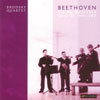Beethoven String Quartets Op 59 Nos 2 & 3
The Brodskys bring plenty of conviction to middle-period Beethoven
View record and artist detailsRecord and Artist Details
Composer or Director: Ludwig van Beethoven
Genre:
Chamber
Label: Brodsky Records
Magazine Review Date: 7/2006
Media Format: CD or Download
Media Runtime: 71
Mastering:
Stereo
DDD
Catalogue Number: BRD3502

Tracks:
| Composition | Artist Credit |
|---|---|
| String Quartet No. 8, 'Rasumovsky' |
Ludwig van Beethoven, Composer
Brodsky Quartet Ludwig van Beethoven, Composer |
| String Quartet No. 9, 'Rasumovsky' |
Ludwig van Beethoven, Composer
Brodsky Quartet Ludwig van Beethoven, Composer |
Author: DuncanDruce
This isn’t just another Rasumovsky recording: the Brodskys manage to sound thoroughly individual without ever seeming eccentric or one-sided. They pay close attention to detail – balance, articulation and accentuation are all carefully controlled – but as part of a performance full of conviction. One might argue that the interpretation is in places excessively literal: in the second quartet’s first movement, for instance, where Beethoven writes staccato dots only at the start of a passage, it seems likely he intended the same articulation to persist. But the Brodsky performance, becoming smoother after the first bar (track 1, 2’00”), is convincing enough to prompt one to question such an assumption.
For the majority of movements the Brodskys stay close to Beethoven’s metronome indications: the extraordinarily swift Presto finale of No 2 is revelatory and, in No 3, the flowing Andante con moto quasi allegretto, and the following Minuet, spacious and truly grazioso, would surely have pleased the composer. No 2’s Molto adagio moves serenely onwards at Beethoven’s suggested 60 beats per minute: it’s a lovely performance, but there’s no doubt that groups adopting a slower speed – the Takács or the Busch, for example – achieve greater intensity.
The Brodskys don’t always observe the metronome marks, however. For No 3’s finale the tempo is slower than in many versions; but what’s lost in brilliance is gained in dramatic power. And in No 2’s opening Allegro, moderate and unhurried, we may miss something of the music’s impulsive, disturbed character but can focus on a wealth of expressive detail. So it’s well worth hearing this, however many Rasumovskys you have in your library.v
For the majority of movements the Brodskys stay close to Beethoven’s metronome indications: the extraordinarily swift Presto finale of No 2 is revelatory and, in No 3, the flowing Andante con moto quasi allegretto, and the following Minuet, spacious and truly grazioso, would surely have pleased the composer. No 2’s Molto adagio moves serenely onwards at Beethoven’s suggested 60 beats per minute: it’s a lovely performance, but there’s no doubt that groups adopting a slower speed – the Takács or the Busch, for example – achieve greater intensity.
The Brodskys don’t always observe the metronome marks, however. For No 3’s finale the tempo is slower than in many versions; but what’s lost in brilliance is gained in dramatic power. And in No 2’s opening Allegro, moderate and unhurried, we may miss something of the music’s impulsive, disturbed character but can focus on a wealth of expressive detail. So it’s well worth hearing this, however many Rasumovskys you have in your library.v
Discover the world's largest classical music catalogue with Presto Music.

Gramophone Digital Club
- Digital Edition
- Digital Archive
- Reviews Database
- Full website access
From £8.75 / month
Subscribe
Gramophone Full Club
- Print Edition
- Digital Edition
- Digital Archive
- Reviews Database
- Full website access
From £11.00 / month
Subscribe
If you are a library, university or other organisation that would be interested in an institutional subscription to Gramophone please click here for further information.




